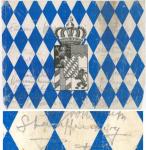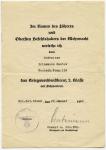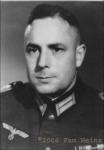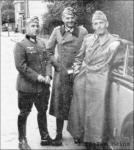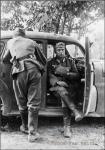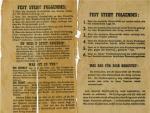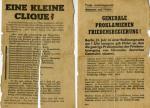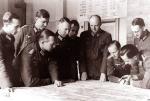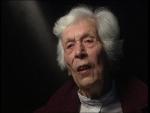-
Posts
701 -
Joined
-
Last visited
-
Days Won
1
Content Type
Profiles
Forums
Blogs
Gallery
Events
Store
Everything posted by ColinRF
-
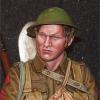
Stauffenberg signed photo - 17. Reiter
ColinRF replied to ColinRF's topic in Germany: Weimar Republic & Deutsche Freikorps
-

Stauffenberg signed photo - 17. Reiter
ColinRF replied to ColinRF's topic in Germany: Weimar Republic & Deutsche Freikorps
-

Stauffenberg signed photo - 17. Reiter
ColinRF replied to ColinRF's topic in Germany: Weimar Republic & Deutsche Freikorps
Thanks Les - Robert Karl Banfield is on the rolls of 1. Schwere Reiter so it must be him as almost every officer signing this piece was a member of this regiment at this time and Stauffenberg's Uncle Berthold was Colonel. I expect the newly minted officer cadet Claus would have been sitting with these vets or would have been intoruduced to them by his Uncle at the dinner. I acquired another piece signed by Stauffenberg and many of the same individuals when I purchased this one. I later sold that one at auction. It was a replica Bavarian standard printed on cloth with pencil signatures. Here's a scan Thanks Colin -

Stauffenberg signed photo - 17. Reiter
ColinRF replied to ColinRF's topic in Germany: Weimar Republic & Deutsche Freikorps
I have made some significant progress on identifying these signatures thanks to the publication of the various WWI Bavarian army rangliste documents through Ancestry.de. Its an awesome resource. Here is the updated log of signatures, almost all of which are officers of 1. Schwere Bayerisches Reiter Regiment. Those few who are not of this regiment were members of brigade or army staff. Claus Schenk Graf von Stauffenberg must have had his Uncle Berthold's comrades from this regiment sign the paper that was ultimately affixed to his copy of the photo of the alumni dinner in 1929. Note that Eisner assassin Graf Arco Valley did indeed serve in this cavalry regiment before later transferring to I. Lieb Infanterie. 1 Eckart Anton von Pappus und Trazberg Freiherr Zu Laubenberg und Rauhenzell 2 Richard Walther 3 Berthold Schenk Graf von Stauffenberg 4 Ferdinand von Kobell 5 Hans Freiherr von Koenitz 6 Hartmann Maria Frhrr von Ow Auf Wachendorf 7 August Freiherr Teuffel von Birkensee 8 Karl Wilhelm Leonhard Czermak 9 unknown 9 10 unknown 10 11 unknown 11 12 Stephan Freiherr Reichlin von Meldegg 13 Graf Anton Alfred Emil Hubert Georg Arco Auf Valleÿ 14 Hans Erwin August Friedrich Bresselau von Bressensdorf 15 Oskar Frieherr Kress von Kressenstein 16 Heinrich Freiherr von Koenitz 17 Heinrich Freiherr von Aretin 18 Franz Freiherr Redwitz 19 Leonard (or Hans) Räth 20 Joseph Ernst Hermann Theodor Karl Maria Erbgr. Fugger von Gloett 21 Karl Graf von Moy 22 Karl Freiherr Von Speidel 23 Carl Max Graf Von und Zu Sandizell 24 Ludwig Freiherr von Leonrod 25 Ferdinand Maren Harthard Antoius Michael Josef Prinz von Der Leyen und Zu Hohen Geroldseck 26 Franz Freiherr von Pfetten 27 Albert Freiherr Aretin 28 Robert Karl Banfield 29 Claus Philipp Maria Justinian Schenk Graf von Stauffenberg 30 unknown 30 31 unknown 31 32 Otto Freiherr Von Kramer 33 Karl August Friedrich Freiherr von Bonnet Zu Meautry 34 Josef Fries 35 Rudolf Graf von Marogna-Redwitz 36 Karl Georg Bernhard Ritter von Gonnermann 37 Maximilian Freiherr von Mauchenheim Genannt Bechtolsheim 38 unknown 38 39 Ferdinand Graf von Arco-Zinneberg 40 Claus von Stauffenberg's personal stamp I will post close-ups of the few unknowns later to see if anyone feels inspired to guess. Colin -
No time to write a bio on Lindemann. Here is a summary from the excellent GDW site: Fritz Lindemann (April 11, 1894 - September 22, 1944)Fritz Lindemann fought in the First World War and was a temporary member of the German peace delegation in Versailles in 1919. After 1922 he completed an illegal general staff training course in the Reich Army, and started training officers himself at the end of the 1920s. He was married to Lina von Friedeburg, with whom he had a daughter and two sons. In the Second World War he fought in Poland, France and the Soviet Union, and increasingly used his travel opportunities for contact with the military conspirators, some of whom, including Hellmuth Stieff, were among his close friends. After the unsuccessful assassination attempt of July 20, 1944, Fritz Lindemann managed at first to hide with relatives in Dresden. When his involvement in the plot was discovered, he was given shelter in Berlin by Erich and Elisabeth Gloeden, who helped persecuted Jews as well. The Gloedens were sentenced to death with other helpers in November 1944. Following a denunciation, the Gestapo arrested Fritz Lindemann on September 3, 1944, seriously injuring him. He died in hospital shortly afterwards.
-
Probably one of the most astonishing pieces I have seen from your world-class collection Ian! Absolutely amazing piece. Imagine that Herzner came within day or two of being in the raiding party that would have killed Hitler. Then he basically triggered WWII through his own actions. First he tries to stop it and then he sets it off. Any idea what ultimatey happened to Dr Herzner? Colin
-
Ian - You are correct! See this preview page from Peter Hoffmann's "History of the German Resistance" as confirmation. http://books.google....%201938&f=false Also Michael Heinz' page on his father includes a ref to the leaders of the raiding party - Here's an excerpt - "HEINZ , Franz Liedig (Brigade Ehrhardt), Hans-Jürgen Graf Blumenthal (Offizier), Jürgen von Buttlar (Stahlhelm), Major Döhring (Abwehr II), Haubold Graf Einsiedel, Wolf und Konrad Graf Finckenstein (Stahlhelm), Dr. Fitzner, Grosscurth (Abwehr II), Herbert Hoffmann, Junker (Stahlhelm), Hans-Wolfgang Knaack (Abwehroffizier), Graf von der Recke, Arnold Bistrick, Albrecht Erich Günther (Journalist und Weltkriegsteilnehmer), Ludwig Gehre (Brigade Ehrhardt) und Hans-Albrecht Herzner (Reserveoffizier im IR 9).| Colin
-
Oberstleutnant Friedrich Wlihelm Heinz led a parallel life to his friend Werner Schrader (profiled earlier in this string). Like Schrader, Heinz is often overlooked or marginalized in studies of the anti-Hitler resistance movement in favour of the big hitters like Stauffenberg and Tresckow. Both men served as senior leaders in the nationalist ex-soldiers' organisation, Stahlhelm, both fled to serve in Admiral Canaris' Abwehr to avoid the attentions of the Gestapo. Most importantly, both friends were closely involved in several of the plots against Hitler. Heinz perhaps came closest to pre-empting Hitler's war in the plot that is generally recognised as having the best chance of avoiding WWII. Like many of the resisters, Heinz served in WWI, in the trenches where he was well decorated. Post-war, he served in various Nationalist groups including the Freikorps Ehrhardt where he took part in the Kapp Putsch. He was heavily involved in politics as a right-wing monarchist throughout the inter-war years. He was also a poet and author, skills he directed to use in the political arena. He was an early NS party member but he soon balked at Hitler's dictatorial style and he aligned himself closely with the Strasserite wing of the party. There is some evidence that Heinz was on the elimination list for the Night of the Long Knives. By 1938, Heinz was working actively against Hitler as part of Oster's group in the Abwehr. Heinz was a key planner in the "Oster Conspiracy" that was planned for September 1938. With Beck, Wiztleben, Gisevius, Goerdeler and several others, Heinz planned to arrest Hitler before he could trigger what was considered to be an apocalyptic world war over the Sudetenland in Czechoslovakia. In preparation for arresting Hitler, Heinz recruited a band of approximately sixty men from the Abwehr, the Stahlhelm, universities and socialist organisations. All were issued machine pistols and hand grenades at the HQ of Witzleben's Wehrkreiss III (Berlin). The raiding party, or Stosstruppe, was positioned across the road from the Reichs Chancellory. Diplomat Erich Kordt volunteered to open the Chancellory doors to allow the raiders access to Hitler. Minimal resistance was expected as only a few guards from 1 SS were posted to protect the Fuehrer at this time. The official plan was for Hitler to be arrested and put on trial as most of the conspirators had not yet reached a stage of despair where they were willing to adopt gangster methods to fight the ultimate gangster. Hans von Dohnanyi's archive chronicling SS and Gestapo crimes was to be introduced as evidence. A professional opinion on Hitler's state of mental health was to be provided by eminent psychiatrist Karl Bonhoeffer, Dietrich Bonhoeffer's father. This was high risk as taking time for a trial gave time for the SS and party to stage a counter-coup. However, it must be remembered that Hitler was far less popular in 1938 than he had become a year later after the Munich accords. Nevertheless, Heinz and Oster thought the risk to be unacceptable. After the last planning session was done and the senior plot leaders has departed, Heinz asked to speak to Oster alone. He forcefully made the case that just arresting Hitler would not do and that he must be killed. Although a Christina, Oster agreed. A plot within a plot was designed. Without telling the others, Heinz and Oster agreed that Hitler's death would be engineered during his arrest. History tells us that this raid was never launched. Instead, against all expectations, Neville Chamberlain flew to Munich and gave Hitler everything he requested, thus ensuring a war in the future. He also pulled the rug out form under the plotters who could hardly expect public support for eliminating a leader who had just won such a resounding bloodless victory. The best opportunity to remove Hitler before the outbreak of war disappeared. During the war, Heinz commanded the first battalion of the Abwehr's Brandenburg commandos and later the fourth regiment of the Brandenburg division. He was wounded multiple times and was eventually invalided home to take command of a heavy police battalion in Berlin. On July 20, he was at the Bendlerstrasse for the coup but left empty handed as orders to the various police units were slow in coming. He survived the coup without more than a Gestapo interrogation. After Werner Schrader's suicide, the Gestapo found Dohnanyi's detailed archive of NS crimes as well as prior coup plans. In addition, the Gestapo learned that the archive had been kept in Heinz's brother-in-law's bank vault until Schrader and Heinz moved it to Zossen. The archive detailed Heinz's involvement in the 1938 Oster plot and a warrant was issued. Heinz went to ground in Berlin and unlike many of the conspirators who went into hiding, he managed to stay hidden until war's end. Post-war, Heinz emerged as leader of the Friedrich Wilhelm Heinz Service, a West German intelligence service directly reporting to the West German government, technically in breach of the surrender protocols but tolerated by the western allies who were already realigning to counter the eastern threat. Heinz can be considered one of the fathers of the German secret service. Below is a signature block for Heinz.
-
Robert - here's a ref to von Holwede in Sippenhaft custody with many other family members of July 20 conspirators. He may have been held as a relation (many of the officers were related to multiple conspirators) or he may have been held as a soft suspect with the family members. Colin http://www.moz.de/index.php/Moz/Article/ca...eelow/id/186793
-
Hi Robert - I do not reacll ever seeing a specific reference to either of these officers being implicated in the bomb plot but I would be happy to look through my library of > 100 volumes over the next few days. Neither is mentioned in the index to Hoffmann's monumental "History of the German Resistance" but that index does not cover his detailed notes. Also, keep in mind that while ~200 people lost their lives as a result of the plot, the numbers of arrested were many more, perhaps thousands. You did not have to wind up in front of the People's Court to lose your career after July 20 1944. I will let you know what I find out. Regards Colin
-
Thanks - Ney is in oils and Murat is acrylic. Ney is a 12" sculpt but Murat is small a kit. Colin
-
I am going with Rick's attribution. I'm not sure I follow all the subtleties of the logic but he seems pretty sure of it and that's good enough for me. Unfortunately the most you will probbaly have if you try and sell it is a very strong circumstantial argument in favour of this being Kleist's bar unless you can find some other provenance. But at least you and a few others will know. You could write to the German Resistance Memorial in Berlin (http://www.gdw-berlin.de/service/service-e.php) and ask if they have a photo of Kleist showing his medal bar. If anyone has one they will. Explain your situation and ask politely for a scanned copy of anything they have. I have found them to be very helpful and responsive in the past. Colin
-
Another ref to him in Tresckow's wiki article. http://en.wikipedia.org/wiki/Henning_von_Tresckow a reference to Kleist losing his leg by Schlabrendorff http://books.google.ca/books?id=AXk3wS3GAE...num=4#PPA189,M1 and a commentary on Kleist's reliability in his Nuremburg statemnet http://library2.lawschool.cornell.edu/dono..._V_10_09_01.pdf and a photo of Tresckow and Kleist (you can see Kleist is holding a cane in the photo) from http://www.topfoto.co.uk/gallery/valkyrie/...es/ppage41.html Colin
-
Interesting you reference Stauffenberg - there was an Oberstleutnant Berndt von Kleist in Tresckow's resistance cell in Army Group Centre and he was a member of Tresckow's regiment 1. Prussian foot guards. I suspect this is his medal bar - that of a major July 20 resister. I am envious. See - http://books.google.ca/books?id=212hoVrF3B...1#PRA1-PA265,M1 Colin
-
Freya von Moltke (nee Deichmann) was the wife of resister Helmuth James von Moltke and at this date is one of the few survivors. While many of the women of the resistance provided support to their husbands without being directly involved, Freya was actually a member of the Kreisau Circle, a group of intellectuals who planned for the post-Hitler period. The circle was named for the von Moltke estate that was located near Kreisau in East Prussia. Helmuth James von Moltke was a Rhodes Scholar and his mother was English. She was the daughter of the ex-Chief Justice of South Africa. Freya moved with Helmuth to Berlin in 1932 and obtained her doctorate in law in 1935. Helmuth too was a lawyer. He founded a practice in international law in 1035 and began to train as an English barrister, qualifying in 1938. He provide legal aid to Jews and other Nazi victims and like many opponents of the Party, he was taken into Abwehr in 1939 at the beginning of the war. His role within the Abwehr was to act as technical expert on the laws of war. In 1940, Helmuth and Freya met Peter Yorck von Wartenburg. Together with Yorck, the von Moltke?s gathered a group of friends to plan for post-war government. Meetings were held at the Kreisau estate in 1942 and 1943. The core of the group amounted for about 20 people. Starting 1941, links were forged with the civilian and military arms of the resistance. Moltke was initially opposed to assassination but Freya noted that he later came around to supporting the coup. Helmuth was arrested in early 1944 after he was implicated by another who was tortured after arrest. He remained in jail until the Gestapo learned about the Kreisau Circle after July 20. He was condemned to death by the People?s Court on January 11, 1945 and he was condemned to death 12 days later. Freya survived the war. She was never arrested or held in family custody. Before the end of the war she returned to Kreisau where she rescued her children and all of Helmuth's letters, many of which had been smuggled out of prison and hidden in a bee hive. These letters were published as "Letters to Freya." They form a very compelling history or the civilian side of the resistance.
-
Thanks Naxos - I just finished his book. Although he is not the last survivor of the bomb plot as billed on the cover and within - that would be Ewald Heinrich von Kleist. I believe Freya von Moltke of Kriesau fame is also still with us. Returning the favour, here is a link to an MP3 1/2 hour interview with Claus' eldest son Berthold - fascinating. http://images.google.ca/imgres?imgurl=http...%3Doff%26sa%3DN Colin
-
Thanks! Hope you enjoy Valkyrie. Strangely the reviews of the DVD seem a lot more positive than those of the cinematic release. I have the digital copy on my lap top and put it on while cooking. Perhaps folks can get more of a handle on the hsitory with the voiced commentaries and the documentary. BTW - did you ever write away for that signature? YOu will kick yourself if you don"t. :-) PS - what medal bar? Colin
-
Still a few to add...sorry I've been out of commission for a while. Josef Wagner was Gauleiter of Westphalia-South from 1928 to 1941 and was also Gauleiter of Silesia between 1934 until 1941. He was deemed capable enough to run two districts simultaneously. He was directly involved as Goerdeler's successor as Reich Price commissioner in introducing anti-inflationary price controls and he appears to have been valued by Hitler. He was one of the earliest members of the Nazi party, joining it in 1922. He was involved peripherally in the resistance. Ulrich von Hassel includes Wagner as one of the best Gauleiters in his secret diary and he also notes that Wagner sent him a warning on at least one occasion that he was under Gestapo surveillance. When Werner Schrader's safe was opened by the Gestapo after his July 28, 1944 suicide, they found Oster's list of members of the 1938 coup attempt, Wagner's name was on the list. In addition, his assistant during his tenure as Silesian Gauleiter was none other than Frtiz Dietlof Graf von Schulenburg, later Helldorf's deputy in the Berlin police and a key player in the July plot. It is more than likely that these Stauffenberg associations led directly to his ultimate fate. On the other hand, Wagner should not be white washed as he was a key player in some of the first anti-Jewish deportations from Silesia. Wagner was a devout Catholic and he had contacts with several members of the German resistance including Beck, Hassel and Goerdeler from an early date. His devout religiousness, which included sending his children to Catholic schools, earned him the disdain of Martin Bormann, a dangerous enemy. His fall from grace occurred in 1941 when Wagner's pregnant daughter announced her intention to marry an SS officer. Wagner and his wife refused to permit the match as the prospective groom had an unsavoury reputation and was a non-Catholic. Wagner's wife wrote to her daughter to explain her parents' reasons for withholding permission to marry but the letter was intercepted by Bormann, perhaps with Himmler's connivance. On the afternoon of November 9, 1941, in front of the assembled Reichsleiters and Gauleiters, Hitler publicly proclaimed that he would not stand for such behaviour. Wagner was stripped of his offices and drummed out of the party on the spot. The case was then taken before Walter Buch, the Party's supreme judge. Wagner was 'tried' before a jury of six peer Gauleiters and Wagner defended himself so ably that they dismissed the charges and ordered his reinstatement to all his old offices. Not for the first or last time, Hitler personally intervened and overturned this decision made under due process. Wagner's ultimate fate is unclear. It is known that he was arrested after the Stauffenberg bomb plot and incarcerated in a KZ. Most authorities think he was secretly murdered by the SS in the waning days of the war, much like General Rabenau. One source says he was hung in Berlin on April 22, 1945. Others believe that he was made to disappear by Soviet troops after liberation.




